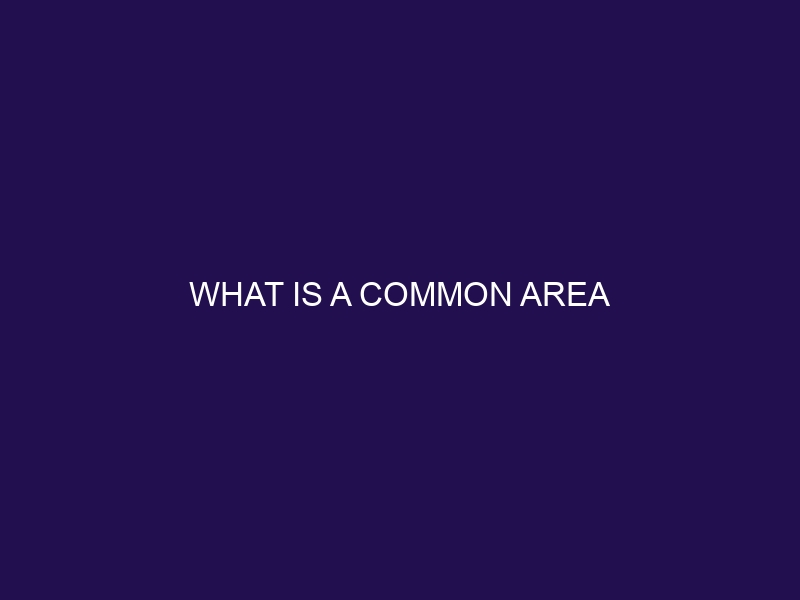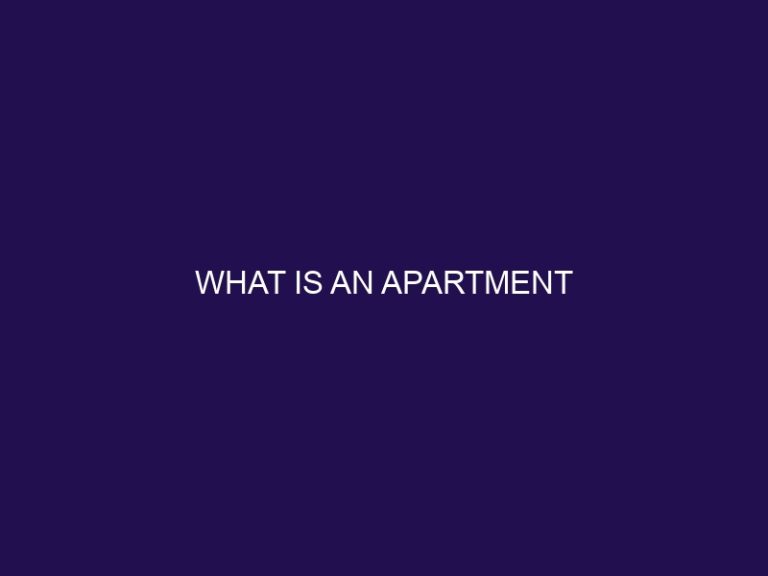What is a Common Area
Common areas refer to shared spaces within a building or community that are accessible to multiple individuals. These areas are characterized by their shared ownership or use and the responsibility for their maintenance. Common areas serve as vital components of residential, commercial, and public spaces, fostering community, enhancing property value, and promoting safety and security.
Residential buildings commonly have common areas such as lobbies, hallways, elevators, and outdoor spaces like courtyards and gardens. Commercial buildings also contain common areas, including shared conference rooms, break rooms, and restrooms. Public spaces, such as parks and shopping centers, have common areas that facilitate social interaction and public gatherings.
Common areas play a crucial role in fostering community and social interaction among residents or users. They serve as gathering spaces, encouraging residents to connect and engage with one another. Well-maintained common areas contribute to the overall aesthetic appeal of a property, enhancing its value.
Furthermore, common areas promote safety and security by providing well-monitored spaces and creating a sense of community vigilance. They often come under the governance of governing documents, homeowners’ associations, or condominium associations, which enforce rules and regulations to ensure proper maintenance and usage. Proper maintenance of common areas involves regular cleaning, repairs, and upkeep, with funding and budgeting being crucial aspects of their management.
Understanding the definition, characteristics, types, and importance of common areas, along with the legal aspects and governance surrounding them, is essential for property owners, residents, and users alike. Effective management and maintenance of these spaces contribute to the overall quality of life and satisfaction within a building or community.
Definition of a Common Area
A common area, also known as a shared space, is a designated area within a larger residential or commercial property that is easily accessible to all occupants. These areas, such as lobbies, hallways, elevators, community rooms, swimming pools, and fitness centers, are typically managed and maintained by either a homeowners association or a property management company. They are specifically intended for the use and enjoyment of all residents or tenants, adhering to certain rules and regulations. The main purpose of a common area is to encourage a sense of community and provide amenities that enhance the overall living or working experience.
Centuries ago in ancient Rome, common areas were referred to as “atriums,” which served as central courtyards where individuals gathered for various social and civic activities. These vibrant spaces were often adorned with statues, fountains, and seating areas, and they played a pivotal role in fostering community interactions. As the heart of the property, atriums were open to all residents, serving as hubs for socializing, conducting business, and hosting public events. Although the concept of common areas has since evolved, the fundamental principle of creating shared spaces that promote community engagement remains unchanged.
Characteristics of Common Areas
Common areas, the heart of shared spaces. From residential buildings to commercial spaces and public places, these unique areas bring people together. In this section, we’ll uncover the key characteristics that define common areas. Whether it’s the accessibility for multiple individuals, shared ownership, or the responsibility of maintenance, we’ll dive into what makes these spaces truly communal. Let’s explore the fascinating world of common areas and the roles they play in our daily lives.
Accessible to Multiple Individuals
Access to common areas is a key characteristic that makes them an important feature in various settings. These areas are designed to be accessible to multiple individuals, providing spaces for interaction and convenience. They are shared by residents, employees, or the public, depending on the specific setting. Examples of common areas include lobbies, hallways, elevators, and outdoor spaces. In residential buildings, common areas foster community and social interaction among residents. In commercial buildings, they promote collaboration and productivity among employees. In public spaces, common areas serve as gathering places for people to relax or engage in activities. Accessible to multiple individuals, these common areas contribute to a sense of community and enhance the overall experience for individuals utilizing these spaces.
Shared Ownership or Use
Shared ownership or use is a fundamental characteristic of common areas. These spaces are accessible to multiple individuals who hold shared ownership or have the right to use them. Common areas can be found in residential, commercial, and public spaces, including lobbies, hallways, elevators, and outdoor areas. They play a vital role in fostering community and social interaction, while also enhancing property value and promoting safety and security. The legal aspects and governance of common areas are outlined in governing documents, such as the rules and regulations established by homeowners’ associations or condominium associations. Proper maintenance and effective management are crucial, with responsibilities and funding allocated accordingly. It’s worth noting that well-maintained common areas have the potential to increase property values by up to 20%.
Maintenance Responsibility
The maintenance responsibility of common areas is an important aspect in property management. It involves ensuring that these shared spaces are properly maintained and kept in good condition. This responsibility typically falls on the property owner or the homeowners’ association, depending on the type of property.
Here is an example of a table showcasing the maintenance responsibility of common areas:
| Common Area | Maintenance Responsibility |
|---|---|
| Lobbies | Homeowners’ Association |
| Hallways | Property Owner |
| Elevators | Property Owner |
| Outdoor Spaces | Homeowners’ Association |
The table demonstrates the division of maintenance responsibilities between the different stakeholders involved in managing common areas.
Common Areas in Residential Buildings
In residential buildings, common areas are communal spaces that are shared and accessible to multiple individuals living in the building. These Common Areas in Residential Buildings serve as a hub for community interaction and contribute to the overall quality of living.
- Lobby and entrance: The first impression of a building, serving as a gathering place and a point of entry.
- Hallways and corridors: Connect individual units to Common Areas in Residential Buildings and facilitate movement within the building.
- Elevators and staircases: Essential for vertical transportation and accessibility.
- Outdoor spaces: Such as gardens, playgrounds, or rooftop terraces, providing residents with opportunities for relaxation and recreation.
Having well-maintained and managed Common Areas in Residential Buildings enhances the sense of community, increases property value, and promotes safety and security. It is important for homeowners’ associations or condominium associations to establish clear governing documents, rules, and regulations to ensure proper maintenance and funding for these Common Areas in Residential Buildings.
Suggestions for improving Common Areas in Residential Buildings include incorporating seating areas, installing artwork or greenery, organizing community events, and providing amenities that cater to residents’ needs and preferences. These efforts can contribute to a vibrant community atmosphere and enhance the overall living experience for residents.
Common Areas in Commercial Buildings
In commercial buildings, common areas play an important role in providing essential facilities for tenants, employees, and visitors. These shared spaces promote interaction and contribute to the overall functionality of the building.
| Common Areas |
|---|
| 1. Lobbies and Entrances |
| 2. Hallways and Corridors |
| 3. Elevators and Staircases |
| 4. Restrooms and Washrooms |
| 5. Cafeterias and Breakrooms |
| 6. Fitness Centers and Gyms |
| 7. Parking Areas and Garages |
| 8. Conference Rooms and Meeting Spaces |
| 9. Outdoor Courtyards and Gardens |
| 10. Maintenance and Utility Rooms |
These areas serve multiple individuals, provide shared amenities, and require regular maintenance and cleaning. They contribute to the overall appeal and value of the building, making it attractive to potential tenants or investors. Proper management of common areas is essential to ensure a pleasant and functional environment for everyone.
Common Areas in Public Spaces
- Parks and recreational areas: These public spaces often have designated common areas where people can gather, relax, and engage in various activities. These common areas in public spaces serve as shared spaces for individuals to come together and enjoy leisure time.
- Plazas and squares: Found in urban areas, plazas and squares serve as central meeting points and often host events, performances, and markets. These common areas in public spaces are designed to bring people together and foster a sense of community.
- Public transportation stations: Train stations, bus stops, and airports typically have common areas where travelers can wait, rest, and access amenities. These common areas in public spaces offer convenient and comfortable spaces for commuters to relax and wait for their transportation.
- Libraries and museums: These cultural institutions often have common areas where visitors can gather, read, study, and appreciate exhibits. These common areas in public spaces provide individuals with opportunities to engage in intellectual activities and connect with others who share similar interests.
- Community centers: These spaces provide a range of services and activities for the public, including classes, events, and meeting areas. These common areas in public spaces are the heart of community engagement, offering a variety of resources and opportunities for individuals to come together and contribute to their community.
Examples of Common Areas
Get ready to explore the various examples of common areas in this section! We’ll dive into the fascinating world of lobbies and entrances, delve into the charm of hallways and corridors, discover the hidden beauty of elevators and staircases, and venture into the refreshing outdoor spaces. So, buckle up and prepare to be inspired by these diverse common areas that play a crucial role in our daily lives. Get ready for a journey through the heart of shared spaces!
Lobbies and Entrances
Lobbies and entrances in buildings are crucial common areas that play a vital role in creating a first impression and fostering a welcoming atmosphere for both residents and visitors. By carefully considering a few key aspects, these spaces can truly reflect the overall aesthetic of the building.
Attention should be given to the design of lobbies and entrances, ensuring that they not only appear visually appealing but also serve a functional purpose. By incorporating elements that harmonize with the building’s overall aesthetics, a cohesive and pleasing ambiance can be achieved.
To enhance the comfort and ambiance of these areas, it is recommended to include seating areas, suitable lighting, and decorative elements. These amenities will make the space more inviting and provide residents and visitors with a pleasant experience.
Maintaining a high level of safety and security in these areas is of utmost importance. Implementing access control systems and surveillance cameras can help ensure the safety of residents while effectively managing visitor entry.
Furthermore, it is crucial to ensure that the lobbies and entrance areas are easily accessible for individuals with disabilities, complying with the ADA guidelines. By taking these measures, we can guarantee inclusivity and create an inclusive environment for everyone.
Lastly, regular cleaning and maintenance are essential in creating a positive and inviting environment. Keeping these areas clean and well-maintained will contribute to an overall positive atmosphere and make a lasting impression on residents and visitors alike.
Hallways and Corridors
Hallways and corridors are vital common areas in buildings, serving as pathways that connect different units and shared spaces. These spaces play a crucial role in providing access to various parts of the property. Moreover, well-designed and properly maintained hallways and corridors contribute significantly to the overall aesthetic appeal of a building. Here are some key features that define well-designed hallways and corridors:
- – Spaciousness: Wide hallways create a sense of openness and facilitate the smooth movement of both residents and visitors.
- – Lighting: Adequate lighting is essential as it ensures safety and enhances the visual appeal of the space.
- – Security: To promote a sense of security, it is vital to have proper surveillance systems and strategically placed emergency exits.
- – Acoustic consideration: Including sound dampening features helps minimize noise transmission and maintain a peaceful and quiet environment.
- – Decoration and aesthetics: Adding artwork, plants, and other decorative elements can bring charm and personality to hallways and corridors.
Throughout the history of architecture, hallways and corridors have transformed from basic passageways to spaces that reflect the style and ambiance of the building. For instance, the grand hallways in historic European castles are adorned with intricate ceiling moldings, ornate wall decorations, and luxurious marble flooring, creating a sense of opulence and grandeur. These historical examples exemplify the significance of hallways and corridors in creating unforgettable architectural spaces.
Elevators and Staircases
Using elevators and staircases is an essential part of navigating common areas in buildings. Elevators and staircases should be designed and maintained with accessibility in mind, ensuring they are accessible to individuals with disabilities. Regularly inspect elevators and staircases to ensure they meet safety codes and are free from hazards. Conduct routine maintenance on elevators and staircases to keep them in proper working condition. To improve efficiency, optimize elevator systems to minimize wait times and improve traffic flow in multi-story buildings. In addition, it is important to install emergency lighting and communication systems in elevators and staircases to ensure safety during power outages or other emergencies.
Outdoor Spaces
Outdoor spaces are an important component of common areas in residential, commercial, and public buildings. They provide an opportunity for individuals to interact with nature and engage in recreational activities. Here is a list of examples of outdoor spaces found in common areas:
- Gardens and landscaped areas
- Patios and terraces
- Playgrounds and parks
- Courtyards and plazas
- Roof decks and balconies
These outdoor spaces contribute to the overall ambiance and attractiveness of a building, providing residents, employees, or visitors with a relaxing environment. They can also serve as a gathering place or a venue for events and social activities. Proper maintenance and management of these outdoor spaces are crucial to ensure their functionality and enjoyment for everyone.
The Importance of Common Areas
Common areas play a vital role in any community, bringing people together and adding value to their properties. In this section, we’ll uncover the significance of these spaces by exploring how they foster community and social interaction, enhance property value, and promote safety and security. So, get ready to dive into the exciting world of common areas and discover how they contribute to the overall well-being and cohesiveness of a community.
Fostering Community and Social Interaction
Fostering community and social interaction is essential in common areas. It plays a vital role in creating a sense of belonging and cultivating a positive living or working environment. Here are some ways to naturally foster community and social interaction in common areas:
In one apartment building, an outstanding example of fostering community and social interaction is a common rooftop garden. This beautiful space encourages residents to come together, unwind, and appreciate the breathtaking views. The garden has become a beloved spot for various community activities, ranging from yoga classes to barbecue parties. Through these events, strong connections have formed among neighbors, ultimately contributing to a vibrant social atmosphere.
Enhancing Property Value
Enhancing Property Value
Enhancing the value of a property is an important consideration when it comes to common areas. Well-maintained and attractive common areas can have a positive impact on property values and overall desirability. Here are some ways in which common areas can enhance property value:
- 1. Curb Appeal: Common areas that are well-kept and visually appealing can create a positive first impression for potential buyers or tenants, increasing the attractiveness of the property.
- 2. Amenities: Common areas that offer desirable amenities such as gyms, swimming pools, or outdoor recreational spaces can add significant value to a property.
- 3. Sense of Community: Common areas that encourage social interaction and community engagement can create a sense of belonging and enhance the overall quality of life for residents or tenants, making the property more desirable.
- 4. Safety and Security: Common areas that are well-lit, properly maintained, and equipped with security measures can provide a sense of safety and security, which is highly valued by potential buyers or tenants.
- 5. Maintenance and Management: Efficient maintenance and management of common areas reflect a well-functioning community, instilling confidence in potential buyers or tenants and adding value to the property.
Promoting Safety and Security
- Promoting safety and security in common areas is crucial for ensuring a secure environment for residents and visitors.
- One of the measures that can be implemented to ensure safety and security is the installation of surveillance cameras to monitor activity and discourage criminal behavior.
- Proper lighting in all common areas is another important aspect to improve visibility and deter potential threats.
- Regular maintenance of locks, security systems, and access control mechanisms is necessary to ensure their effectiveness.
- An effective way to keep track of individuals entering and exiting the premises is through the implementation of a visitor management system.
- To maintain order and safety, clear rules and regulations should be established for the use of common areas, and these rules should be enforced through a designated authority.
- Having regular security patrols and the presence of security personnel is essential to promptly address any security concerns that may arise.
- Training programs and educational initiatives play a significant role in raising awareness about personal safety and security precautions.
Legal Aspects and Governance of Common Areas
When it comes to the legal aspects and governance of common areas, there are several key elements to consider. From the governing documents that establish the rules and regulations, to the role of homeowners’ associations and condominium associations, each sub-section in this article will shed light on essential aspects that ensure a smooth and harmonious coexistence within these shared spaces. So, let’s dive in and explore the legal framework that shapes common areas and the dynamics behind their governance.
Governing Documents
Governing documents play a crucial role in the management and regulation of common areas. They establish the rules and guidelines that govern the use, maintenance, and responsibilities of shared spaces. These governing documents outline the rights and obligations of property owners or members of a homeowners’ association or condominium association. Key components of governing documents include bylaws, declarations, and rules and regulations. Bylaws set forth the organization’s structure and procedures, declarations define the legal boundaries of common areas, and rules and regulations provide specific guidelines for behavior and use. Properly drafted governing documents ensure a harmonious and organized community, protecting the interests of all involved parties.
Homeowners’ Associations and Condominium Associations
Homeowners’ Associations (HOAs) and Condominium Associations play a crucial role in the management and governance of common areas in residential communities. Here are some key points to consider:
- HOAs and Condominium Associations: These organizations are responsible for maintaining and managing common areas, ensuring they are well-maintained and enhancing property values.
- Governing Documents: HOAs and Condominium Associations have specific rules and regulations outlined in their governing documents that dictate how the common areas should be used and maintained.
- Rules and Regulations: These Associations establish rules and regulations to govern the use of common areas, ensuring a harmonious living environment for all residents.
When choosing a home or condominium, it’s important to consider the effectiveness and reputation of the Homeowners’ Associations and Condominium Associations. Look for transparent communication, fair management, and a strong track record of maintaining common areas.
Rules and Regulations
When it comes to common areas, rules and regulations are of utmost importance in maintaining order and ensuring the well-being of everyone involved. Some crucial aspects to consider include:
- Establishing clear guidelines: Rules and regulations that are well-defined help to maintain a harmonious environment and prevent conflicts.
- Use and behavior guidelines: Rules pertaining to noise levels, cleanliness, and respectful behavior contribute to creating a pleasant and safe atmosphere for all.
- Security measures: Regulations concerning access control, visitor policies, and surveillance systems significantly enhance the overall safety of the common areas.
- Maintenance responsibilities: Rules that outline the maintenance and upkeep of shared spaces ensure that they remain in optimal condition for everyone to enjoy.
- Enforcement mechanisms: Procedures for addressing violations and penalties for non-compliance play a vital role in ensuring accountability and adherence to the rules.
Maintaining and Managing Common Areas
Maintaining and managing common areas can be quite a task, but understanding the key aspects can help ensure a smooth running. In this section, we will dive into the maintenance responsibilities, funding and budgeting, and long-term planning involved in the maintenance and management of common areas. Get ready to explore the essential elements behind the upkeep and sustainability of these shared spaces.
Maintenance Responsibilities
When it comes to maintenance responsibilities, it is crucial to have a clear understanding of who is responsible for what. Here are some key points to consider:
- Maintenance and Cleaning: The management or governing body holds the responsibility for regularly cleaning and maintaining the common areas.
- Repairs and Upkeep: Any necessary repairs or maintenance in the common areas should be promptly addressed by the responsible party.
- Landscaping: If the common areas include outdoor spaces, the management or landscaping team is typically responsible for maintaining the landscaping and ensuring its upkeep.
- Security: Ensuring the security of common areas, such as the installation and maintenance of security cameras or access control systems, is typically the responsibility of the management or security team.
By clearly outlining maintenance responsibilities and implementing regular inspections and protocols, the common areas can be properly maintained and enjoyed by all residents or users.
Suggestions:
- Establish a clear communication channel between residents and management regarding maintenance concerns.
- Create a maintenance schedule to ensure regular upkeep and minimize issues.
- Encourage residents or users to promptly report any maintenance issues.
Funding and Budgeting
| Funding and Budgeting Sources | Budget Allocation and Maintenance expenses | Financial Reserves and Emergency repairs |
| Homeowner assessments | Maintenance expenses and Upgrades and renovations | Emergency repairs and Replacement of equipment |
| Rental income and Grants and subsidies | Upgrades and renovations and Utilities and services | Replacement of equipment and Common area insurance |
Effective Funding and Budgeting ensure the long-term sustainability and proper functioning of common areas, benefiting residents and enhancing property value.
Long-term Planning
Long-term planning is vital for the successful management and maintenance of common areas. It entails creating a strategic vision and implementing strategies to guarantee the durability and sustainability of these shared spaces. Several important factors to consider in long-term planning include conducting regular inspections, identifying potential issues, allocating funds for repairs and upgrades, and engaging with residents or stakeholders to comprehend their requirements. By proactively addressing maintenance needs, anticipating future demands, and making well-informed decisions, communities can cultivate thriving and well-maintained common areas that enhance property values and foster a sense of belonging. Ultimately, successful long-term planning contributes to the overall satisfaction and well-being of individuals who utilize and enjoy these shared spaces.
Frequently Asked Questions
What is a common area in a housing common interest development (CID)?
A common area in a housing CID refers to shared spaces or amenities that are accessible to all unit owners or shareholders. It can include yard space, a basketball court, pool, laundry room, or mail room.
What is a common area in a business common interest development (CID)?
In a business CID, a common area can refer to shared spaces like a lobby in a high-rise office building or a parking lot in a mall.
What is the role of the association or board of directors in managing common areas?
The association or board of directors of the CID is responsible for managing the common areas. They oversee the maintenance, repair, and overall management structure of these shared spaces.
What is the difference between common area and exclusive use common area?
A common area belongs to all owners equally and is for shared use. In contrast, an exclusive use common area is a portion of common area designated for the exclusive use of a specific owner, such as a patio, balcony, or deck.
Who is responsible for maintaining common areas?
All owners are responsible for maintaining the common areas in a CID. They must contribute to the CID through periodic fees to ensure proper upkeep of these shared spaces.
What happens if a co-owner fails to pay their share for common area maintenance?
If a co-owner fails to pay their share for common area maintenance, the other owners may have the right to open a court case against them to address the financial responsibility.







